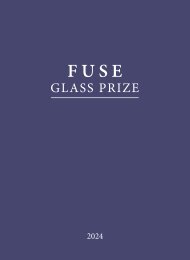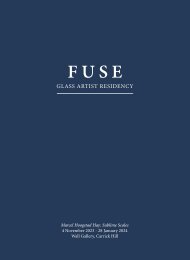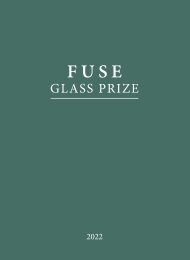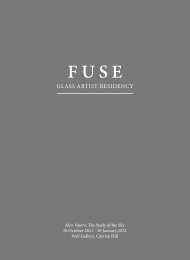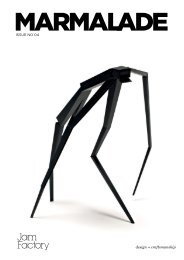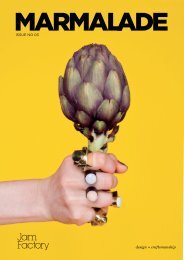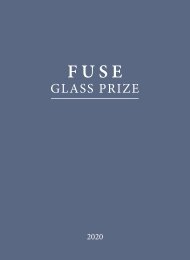Marmalade Issue 5, 2017
You also want an ePaper? Increase the reach of your titles
YUMPU automatically turns print PDFs into web optimized ePapers that Google loves.
concept of locating ‘Indigenous theories, methodologies,<br />
and methods at the centre, not the periphery’ of our society?<br />
While such a shift could ultimately produce ‘an ecological<br />
philosophy of mutual benefit’, getting there will be a<br />
serious challenge.” 5<br />
Without doubt this is a challenge but already we are making<br />
small steps, evident in a range of new connections forming<br />
between Indigenous and non-Indigenous artists and<br />
designers. The weavers of Elcho Island Arts in collaboration<br />
with Koskela is an exciting example of cross-cultural<br />
relationship-building. Shelter, 2015 is a dynamic fusion where<br />
furniture collides with the intricate weavings of the Yolngu<br />
women. The project and partnership has evolved over time<br />
with the Sydney-based design company Koskela making<br />
regular trips to Echo Island to learn from and work with<br />
the women. The powerful work sees cultural techniques<br />
and natural materials traditionally used for ceremonies and<br />
carrying food, reinterpreted into furniture items such as<br />
lampshades and tables.<br />
For the Yolnugu women this is a vital opportunity to show<br />
the rest of Australia what can be done with local materials,<br />
flipping our capitalist hunger for the latest trend from New<br />
York or Paris. The collaboration and use of native materials<br />
also addresses the major crisis of our time – climate change.<br />
The collaboration platforms new levels of resilience and<br />
resourcefulness by switching from cheap mass-produced<br />
plastics and metals to what we have in our own back yard.<br />
When Sasha Titchkosky and Russel Koskela of Koskela first<br />
visited Elcho Island, Mavis Warrngilna Ganambarr, a senior<br />
weaver insisted on taking them shopping straightaway.<br />
Prompting curious looks and the question where are the<br />
shops? Their ignorance made the women laugh because<br />
for them the bush, the shrubs, the trees, the plants and<br />
the natural landscape were the shops. They get what they<br />
need from the land, it surrounds them and it’s free. These<br />
practices and ways of thinking not only generate incredible<br />
art and design but start to show Australia that there is<br />
a new way to progress which works in unison with the<br />
environment rather than contributing to its decline. As Birch<br />
states ‘a shift in mindset is required to produce meaningful<br />
and valuable interactions between Indigenous and non-<br />
Indigenous people.’ 6 Designs created by the Yolungu women<br />
in partnership Koskela highlights this.<br />
TARNANTHI Festival of Contemporary Aboriginal and Torres<br />
Strait Islander Art reflects a movement that is beginning to<br />
emerge across a range of disciplines – from climate change<br />
action to landscape design. Architects, designers, artists and<br />
urban planners are finding dynamic and meaningful ways<br />
to work alongside Aboriginal people and our culture,<br />
creating new ways of being in cities and our own homes.<br />
The festival comes at a time where we must rethink how we<br />
live alongside our environment – a theme which ties in with<br />
other collaborative practices in the design sector.<br />
landscape by reinserting our identity. In 2016 in partnership<br />
with SA Water, he created the Noarlunga Downs Wetland<br />
Sculptures, a series of steel and concrete sculptures in the<br />
stylised form of traditional bark canoes with fishing spears<br />
that were traditionally used as punting poles. A government<br />
water authority collides with the cultural practices of the<br />
Kaurna and Ramindjeri peoples and rigid government land<br />
management practices are stripped back. Aboriginal water<br />
management is honoured, transforming the area from a<br />
treated wastewater storage unit into a thriving wetland<br />
sanctuary marked by Herzich’s striking sculptures.<br />
These Indigenous design interventions can be seen in cities<br />
across the country, revitalising the cold uniformity we are<br />
often accustomed to in the built environment. In Perth, Edith<br />
Cowan University’s Ngoolark building embedded Noongar<br />
knowledge into the architectural design process, creating a<br />
physical experience which links the visitor to Noongar culture,<br />
reminding us it is still here and thriving. A range of projects<br />
have arisen across Melbourne – from Brook Andrews and<br />
Trent Walter’s arresting commemoration to the last Aboriginal<br />
men hung in Melbourne in Standing by Tunnerminnerwait and<br />
Maulboyheenner, 2016 to Megan Cope’s You Are, Here Now,<br />
2015 which combines Woiwrurung language with colonial<br />
maps on the façade of the Australian Catholic University.<br />
More and more Indigenous and non-Indigenous Australians<br />
are creating innovative ways to bring our cultures together,<br />
ensuring that we no longer dilute, erase or tokenise the<br />
traditional custodians of this land.<br />
Nayuka Gorrie has a right to be concerned when she speaks<br />
of economic capital not always flowing onto us and I have<br />
certainly felt Richard Bell’s cynicism. But I also believe we<br />
have learnt and are continuing to create collaborations based<br />
on equity and grounded in the need to enrich who we are<br />
though cross-cultural exchange and solidarity. TARNANTHI<br />
Festival is another way to showcase our growth where artist/<br />
designers like Nicole Monks and Elcho Island Arts weavers<br />
in collaboration with Koskela are creating new ways of being<br />
and a future, which resolves the pain of the past.<br />
Confluence: Contemporary Aboriginal Design exhibits at<br />
JamFactory from 29 September - 26 November as part<br />
of TARNANTHI Festival of Contemporary Aboriginal and<br />
Torres Strait Islander Art.<br />
1. http://www.kooriweb.org/foley/great/art/bell.html<br />
2. Gorrie, N. Cultural Appropriation and Power, The Saturday Paper, 27 May, <strong>2017</strong>.<br />
https://www.thesaturdaypaper.com.au/opinion/topic/<strong>2017</strong>/05/27/culturalappropriation-and-power/14958072004699.<br />
3. Moulton, K. Collecting My Thoughts-Authenticity, The Museum and<br />
Representation, Centre for Indigenous Stories, 2015.<br />
5. http://indigenousstory.com.au/works/128/collecting-my-thoughtsauthenticity-the-museum-and-representation/<br />
4. Recorded in an interview with Sophie Monks.<br />
5. Birch, T. Climate Change, Recognition and Social Place-Making’, The Sydney<br />
Review of Books, 3 March, <strong>2017</strong>. http://sydneyreviewofbooks.com/climatechange-recognition-and-caring-for-country/4<br />
ibid<br />
In Adelaide, Ngarrindjeri/Kaurna/German artist Paul Herzich<br />
works across landscape architecture and public art to create<br />
evocative cultural monuments that soothe the colonial




